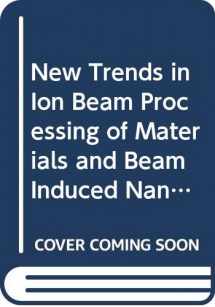
New Trends in Ion Beam Processing of Materials and Beam Induced Nanometric Phenomena (Volume 65) (European Materials Research Society Symposia Proceedings, Volume 65)
ISBN-13:
9780444205063
ISBN-10:
0444205063
Edition:
1
Author:
R. Kelly, J.K.N. Lindner, A. Nylandsted Larsen, J.M. Poate, E.E.B. Campbell, G. Marletta, M. Toulemonde, F. Priolo
Publication date:
1998
Publisher:
Elsevier Science
Format:
Hardcover
640 pages
FREE US shipping
on ALL non-marketplace orders
Marketplace
from $286.03
USD
Marketplace offers
Seller
Condition
Note
Seller
Condition
Used - Like New
Book details
ISBN-13:
9780444205063
ISBN-10:
0444205063
Edition:
1
Author:
R. Kelly, J.K.N. Lindner, A. Nylandsted Larsen, J.M. Poate, E.E.B. Campbell, G. Marletta, M. Toulemonde, F. Priolo
Publication date:
1998
Publisher:
Elsevier Science
Format:
Hardcover
640 pages
Summary
New Trends in Ion Beam Processing of Materials and Beam Induced Nanometric Phenomena (Volume 65) (European Materials Research Society Symposia Proceedings, Volume 65) (ISBN-13: 9780444205063 and ISBN-10: 0444205063), written by authors
R. Kelly, J.K.N. Lindner, A. Nylandsted Larsen, J.M. Poate, E.E.B. Campbell, G. Marletta, M. Toulemonde, F. Priolo, was published by Elsevier Science in 1998.
With an overall rating of 4.5 stars, it's a notable title among other
books. You can easily purchase or rent New Trends in Ion Beam Processing of Materials and Beam Induced Nanometric Phenomena (Volume 65) (European Materials Research Society Symposia Proceedings, Volume 65) (Hardcover) from BooksRun,
along with many other new and used
books
and textbooks.
And, if you're looking to sell your copy, our current buyback offer is $0.3.
Description
Part I of this book is dedicated to the proceedings of symposiumI of the EMRS 1996 Spring Meeting.This Symposium on "NewTrends in Ion Beam Processing of Materials" was held inStrasbourg (France) from the 4th to the 7th of June 1996. Ion-beam processing represents a particularly powerful tool to modifyand synthesise materials such as semiconductors, metals,dielectrics, and ceramics, In particular, the continuousdevelopment of the semiconductor industry, with the consequentshrinkage of device dimensions, is placing severe constraints onion-beam processing with demands for keV and meV energy beams,high doses, and unprecedented control over contamination, beampurity, and divergence. These requirements are posing newchallenges to the ion-beam community, ranging from fundamentalprocesses (such as defect generation, defect-defect interactions,phase transitions) to engineering (such as process control andnovel equipment).The aim of this Symposium was to provide aninternational forum for the presentation and discussion of newwork in the field of ion-beam processing. More than a hundredpapers were presented by scientists from all over the world.particular emphasis was given to new trends in ion-beamprocessing of semiconductors and to the current challenges facedby microelectronic device manufacturing. The fields of transient-enhanced diffusion, gettering, optoelectronic applications, groupIV hetero epitaxy, damage, annealing, and synthesis were treatedin detail. The interaction between the semiconductor and othercommunities is important for the development of new concepts andpresentations in the field of metals, insulators, and newtechniques (such as plasma-immersion ion implantation) wereextremely interesting.Part II is dedicated to the proceedingsof symposium K. This symposium has focused on modifications ofthe structure and properties of materials which are induced byseveral kinds of irradiations: on the one hand highenergy deposited in the electrons which relax their energy to thelattice (fs lasers, heavy ions in the GeV energy range, clusterbeams in the MeV range) and on the other hand energy depositeddirectly on the lattice atoms (heavy ions and cluster beams inthe keV energy range). The idea was to emphasize the link betweenthe material modifications on a nanometric scale and the energyinput on the fs time scale from both the experimental andtheoretical point of view. To reach these goals our attention wasfocused on single event effects: single fs laser shots, singleion and cluster tracks (low and high energy).


We would LOVE it if you could help us and other readers by reviewing the book
Book review

Congratulations! We have received your book review.
{user}
{createdAt}
by {truncated_author}


